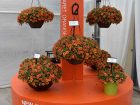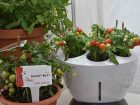
Features
Crops
Flowers
CALIFORNIA 2016: Sampling the best of Spring Trials
A continuing rumour is that the breeders are working to have the event held in one large location. It would save them and the visitors a lot of time and money.
June 8, 2016 By Melhem Sawaya
The California Spring Trials program was started by Glenn Goldsmith in 1967. The goal was to inform growers about the Goldsmith Seeds breeding programs and the company’s commitment to horticulture. It wasn’t long before other breeders joined in, with every major company eventually represented.
The name evolved from the original California Pack Trials, because “packs” are now a very small percentage of the industry.
I prefer to call it the California Showcase, since that’s what it is. Today, there aren’t any trials.
It is a very interesting experience, in the sense that you feel it is a must to attend. After the tour you have a sense of “variety overload,” and are excited to try many of the plants that caught your eye. Then when you get home and start reviewing the pictures and analyzing the whole trip, you end up trying two or three varieties, which is the right approach. Try a limited quantity until you know (1) the most effective growing practices, (2) the consumer response and (3) the garden performance in your area.
If you are visiting the trials for the first time, or if you’ve skipped a few years, then yes, you will still learn something new. The great benefit from visiting the Showcase is to meet the people who you talk to over the phone or direct your e-mail questions to.
In my estimation, less than 25 per cent of the California Showcase participants are growers. It’s really an event that is geared to buyers and, specifically, brokers or chain buyers. Perhaps that is why the trial aspect disappeared. The low grower attendance could also be because they cannot find anything truly new, other than new colours and new cultivars that have not yet been tested.
A continuing rumour at the Showcase is that the breeders are working to have the event held in one large location. It would save them and the visitors a lot of time and money. But it’s just a rumour, because such a decision would require considerable co-operation and common sense, along with the will to change things…and heaven forbid we ever change the way we do things.
I’ve been mentioning this rumour for the last four years when covering the trials. In a sense, it is happening, but in a way I didn’t foresee. Companies are being bought or are amalgamating, and this means fewer players and an event that’s now much tighter geographically.
As noted before, most attendees are chain store buyers hoping for cultivar exclusivity deals with breeders.
And here’s the problem. In my experience, that process is the number 1 factor of profit shrinkage for growers and the chains, and the best recipe for losing more customers because:
- A. The new cultivar didn’t go through a garden performance trial.
- B. No customer appeal study has been done.
- C. The know-how to produce a top-quality product for a specific shipping date has not yet been worked out.
Normally, these exclusive products cost more to the grower. The chain puts the product on the front page of their promotion material – the most expensive section – and the store has to place the product in the most prominent display area.
The breeder sold the product to the chain, which then spent a lot of money advertising a product the consumer will no longer buy because of poor garden performance, if that turns out to be the case. The chain’s credibility is diminished in the eyes of the consumer and, worst of all, the grower is left with a product that cost a great deal to produce. He or she must now incur even more expense to dump it … but not to worry – it’s a recyclable green product.
Increasing the consumption of horticultural products can only be done by helping the consumer be successful and satisfied with their purchase, not by setting them up to fail.
This is the reason I share these varieties with you. They are meant to be trialled at your own facility so you (1) know how to grow them, (2) can track consumer appeal and, last but not least, (3) monitor their garden performance.
The California Showcase that is covered in this issue is only a sample of the hundreds of varieties I viewed during my tour of this year’s sites. Many are new introductions for 2016, others are older varieties with improvements or changes but still carry the same name, and then there are those that have been around for many years but new trends now make them an important variety to share with you.
This is only a sample of the new varieties that we get bombarded with every season. Hopefully with the amalgamations taking place we will see many mediocre cultivars disappear with only the most consumer-friendly products remaining. It has been said so many times that if we are not part of the solution we are part of the problem. Poorly performing varieties turn gardeners off and they might never buy plants again, or at least they won’t buy them from you.
With any new variety (or an old variety that’s new to your operation), remember to try it on a small scale. Evaluate the outcome, and then decide whether to increase its production or delete it. Check with salespeople, consultants, magazines, trial gardens and trade shows for ideas on what to select. They’re all good sources of the latest information.
Almost all of the varieties mentioned in this article will be among the 2,200 cultivars in this year’s Sawaya Garden Trials, located just a few minutes east of Simcoe, Ont., along Hwy. 3. This year’s open house is July 20. Come out to view many of next year’s market winners!
Here are a few varieties that caught my eye at the California Spring Trials (Showcase).
‘Tidal Wave’ (1) is a hedge petunia with a very vigorous growing habit that makes it ideal for outdoor performance. It features long-lasting flowers, very fast rain recovery and botrytis resistance. ‘Tidal Wave’ is great for gardens that
incorporate evergreen shrubs with annual flowers. It is also great in large containers with a trellis and cages, in Al’s Pouches, or in forming a window shutter.
‘Megawatt’ (2) is a large landscape begonia similar in habit to ‘Dragon Wing’ begonia in vegetative growing habit, but with better flower habit. ‘Megawatt’ is great in landscapes and combinations with other vigorous varieties. It looks like an excellent garden performer.
Fusables ‘Paradise Island’ (3) is a three-colour calibrachoa mix from seed. I like the Kabloom seed varieties for hanging baskets because they do not flower early on, thereby lessening the botrytis risk, and yet the flowering and the vegetative habit are well-coordinated to meet sales dates. No pinching is needed for hanging baskets, but pinching is a must for 4″ production.
‘Night Sky’ (4) is a unique blue petunia flower that looks like it is sprayed with white paint. The habit looks good, but we have to wait for the garden performance to see its after-rain recovery along with its flower longevity and habit.
‘Colour Rush’ (5) is a new petunia series that is vigorous, trailing, and covers large landscape areas. Normally vigorous growing petunias do very well in the landscape and have a spectacular show, like the Tidal Waves and Vistas. This summer, ‘Colour Rush’ will be trialled side-by-side with many other petunias in our trials.
Calibrachoa ‘Cabaret Orange’ (6) is improved with excellent mounding and the self-branching habit characteristic of the Cabaret Series. Cabaret is excellent in hanging baskets and combinations with other Cabaret varieties.
‘Canova Series’ (7) is a canna from seed that comes in many colours that will flower by sales date when given enough production time. It has a very flexible height from a finish of six inches to three feet depending on the growing practices. Canova is excellent in landscapes and virus-free, with early branching that will result in a fuller show in the gardens or containers. It is also great as a centre in combinations.
‘Grandessa Yellow’ (8) is one colour of an interspecific argyranthemum series that will flower the whole summer. Grandessa is great in landscapes and containers and as a centre in combinations. It works especially well in combinations for early season sales because it can take cool temperatures. It will last the entire summer and will work well in combination with Wave Pansies, which also flower throughout the summer.
‘Pouchi’ (9) is great as a potted tomato that can be shipped in 5” or 10” pots depending on the growing practices. Try it on a small scale to learn the optimal timing and environment.
‘Surfinia Heartbeat’ (10) is a petunia with heart-shape flowers on a mounding plant. Take advantage of the heart-shaped flower for fundraising promotions or just for regular production in pots, hanging baskets or combinations.
Geranium ‘Cherry Night’ (11) is one colour of the Brocade Series that actually has flowers on absolutely colourful leaves. It has an excellent habit that can be produced in pots for landscapes, hanging baskets or combinations.
‘Paradise Rococo Lavender’ (12) is one colour of double and semi-double flowers in the Rococo Series that makes it a
higher end New Guinea that can be sold at a higher margin. It is great in landscapes and containers.
‘SunStanding Salmon’ (13) is one colour of the new SunStanding Series of impatiens that is downy mildew resistant. Like all other impatiens, it takes the sun and shade quite well, and like all other impatiens it is much more floriferous in sunny locations.
‘Unbelievable Tweetie Pie’ (14) is a Boliviensis type begonia that has excellent garden performance. It is a good idea to try them because it’s my guess the Boliviensis begonia is going to take over the Rieger begonia market in less than three years. ‘Tweetie Pie’ is an additional colour to the Unbelievable Series that displayed great performance in our trials last year. Get to learn how to grow the Boliviensis type begonia so you will be ahead of the curve. They are great in landscapes, sun or shade and in combinations.
This perennial combination (15) is from the Dummen Orange perennial selection. We will have many of these combinations in our trials this summer. We want to see how they look throughout the summer and if they can last late into the fall before being planted in the garden, which translates into excellent value for the consumer.
‘Trilogy Deep Purple’ (16) is a petunia from seed. It is not new but it always looks good in the trials. However, I do not see it much in greenhouses due to weak marketing. Try it and see if it has advantages over mainstream varieties. ‘Deep Purple’ is one colour in the Trilogy Series.
In my opinion, Sunpatiens (17) is the ultimate impatiens for landscapers with sun or shade locations. It’s been tested and proven in our trials in the shade and the sun, and like I said earlier, it has more flower power in the sun. Sunpatiens is great in landscapes, and in containers alone or in combinations. It can be grown in 6” pots with no growth regulators, ensuring its maximum potential in garden performance.
‘Dragon Breath’ celosia (18) can either be very vigorous or not so vigorous depending on the way it is forced. As you can see in the photo, some plants are tasselled and others are not. This is because the short tasselled plants were grown in short-days while the vegetative ones were grown in long-days up to a certain stage. ‘Dragon Breath’ is a facultative short-day plant, which means it will flower without short-days. However, short-days will trigger flowering at a much earlier stage. We tried ‘Dragon Breath’ last year and it has excellent performance through the whole season.
Many petunias that have fancy bi-colour do not have great garden performance, but Colour Works (19) seems to have fancy colours and good performance. It’s good in hanging baskets and combinations.
‘Deep Lavender Stream’ (20) is another colour in the excellent Stream Lobularia Series. It takes the cold, the flowers do not shatter as much as other varieties, and it has different colours. It is great in pots and landscapes where dryness is less likely to happen, since all lobularias do not like to be dried out.
‘Supertunia Vistas’ (21) is one of my favourite petunias because of its excellent reliability in garden performance year after year in containers or landscapes.
Superbells ‘Tropical Sunrise’ (22) is a unique bicolour calibrachoa with a mounding habit that is perfect on its own or in mixes. ‘Tropical Sunrise’ is a self-branching variety that has a mounding habit. Like all other calibrachoa, finishing it cool is the key to a great looking finished product.
‘Large Dark Red’ (23) and ‘Medium Dark Red’ (24) Calliope are two varieties of the same colour but with different vigour. The medium Calliope obviously is not as vigorous but is earlier to flower and puts out more flowers. Grow the
medium variety for early sales and the larger one for later sales. The two sizes need to be grown differently because of a definite vigour difference.
‘Medium Crimson Flame’ (25) has been a well-proven Calliope variety for the past few years. It is one of my favourite geranium varieties for its performance in the greenhouse and outdoors in the landscape, in containers and in combinations.
BIG begonias (26) are great in sun or shade. They hold their flowers high above the foliage and flower all summer long with an excellent garden performance whether they are in landscapes or containers (alone or combinations). It has tested very well in our trials. This picture does not do it any justice. BIG begonia is a favourite with landscapers.
‘Santa Cruz,’ ‘Santa Barbara’ and ‘San Francisco’ (27) are now a series of three colours of a Boliviensis type begonia from seed that is excellent in sun or shade. As we noted earlier, Boliviensis type begonias have a promising future. Make sure it is grown in long-days to get the proper performance. It is good alone and in combinations.
‘Joy’ (28) is the new type of Nonstop begonia that has more of a mounding habit than the regular Nonstop varieties. This makes it ideal for hanging baskets alone or in combinations.
All these varieties will be among the 2,200 in total featured at the Sawaya Garden Trials. The open house is July 20 and everyone is welcome. No pre-registration is needed; enjoy the trials and fellowship, and lunch is provided.
Melhem Sawaya of Focus Greenhouse Management is a consultant and a research co-ordinator to the horticultural industry – mel@focusgreenhousemanagement.com.
Print this page
























